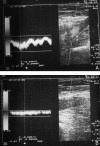Influence of pneumoperitoneum on the deep venous system during laparoscopy
- PMID: 11051187
- PMCID: PMC3113189
Influence of pneumoperitoneum on the deep venous system during laparoscopy
Abstract
Background: There is widespread concern that laparoscopic procedures that are usually performed under general anesthesia, using muscle relaxation, in a reverse Trendelenberg position and with pneumoperitoneum, may lead to venous stasis in lower limbs.
Objective: To evaluate perioperative changes in the venous system and determine the frequency of deep venous thrombosis associated with minimally invasive surgery.
Design: Prospective consecutive series.
Subjects: Sixty-five patients undergoing elective minimally invasive surgery.
Intervention: Laparoscopic procedures with no thromboprophylaxis.
Results: Sixty-one patients completed the investigations (coagulation profile and lower limb venous duplex scan) on admission and on the first postoperative day. The median duration of pneumoperitoneum was 45 minutes (range: 18-90 minutes). None of postoperative scans revealed thrombosis. No significant changes in the postoperative coagulation profile were identified. Perioperative scans of the left femoral vein revealed an increase in cross-sectional area (P<0.05) and a decrease in peak blood velocity (P<0.05).
Conclusion: In this study of low-risk patients for thromboembolism, laparoscopy with pneumoperitoneum at pressures below 12 mm Hg per se did not increase the prevalence of deep venous thrombosis. This implies that venous hemodynamic changes observed during pneumoperitoneum did not cause deleterious venous stasis. Still, caution needs to exercised with regard to the view that no special precautions to prevent deep venous thrombosis are warranted in patients undergoing laparoscopy.
Figures
Similar articles
-
[Venous stasis and deep vein thrombosis prophylaxis during laparoscopic fundoplication].Zentralbl Chir. 2002 Nov;127(11):944-9. doi: 10.1055/s-2002-35828. Zentralbl Chir. 2002. PMID: 12476366 Clinical Trial. German.
-
Venous stasis during laparoscopic cholecystectomy.Surg Laparosc Endosc. 1994 Apr;4(2):128-33. Surg Laparosc Endosc. 1994. PMID: 8180764 Clinical Trial.
-
Evidence of venous stasis after abdominal insufflation for laparoscopic cholecystectomy.Surg Gynecol Obstet. 1993 May;176(5):443-7. Surg Gynecol Obstet. 1993. PMID: 8480266
-
Intermittent sequential pneumatic compression in prevention of venous stasis associated with pneumoperitoneum during laparoscopic cholecystectomy.Arch Surg. 1993 Aug;128(8):914-8; discussion 918-9. doi: 10.1001/archsurg.1993.01420200088016. Arch Surg. 1993. PMID: 8343064
-
The physiologic effects of pneumoperitoneum in the morbidly obese.Ann Surg. 2005 Feb;241(2):219-26. doi: 10.1097/01.sla.0000151791.93571.70. Ann Surg. 2005. PMID: 15650630 Free PMC article. Review.
Cited by
-
Deep venous thrombosis in lap band surgery: a single center study.Indian J Surg. 2012 Apr;74(2):146-8. doi: 10.1007/s12262-011-0363-x. Epub 2011 Nov 16. Indian J Surg. 2012. PMID: 23542571 Free PMC article.
-
Association Between Operative Approach and Venous Thromboembolism Rate Following Hepatectomy: a Propensity-Matched Analysis.J Gastrointest Surg. 2021 Nov;25(11):2778-2787. doi: 10.1007/s11605-020-04887-x. Epub 2020 Nov 24. J Gastrointest Surg. 2021. PMID: 33236321
-
Prevention of VTE in nonorthopedic surgical patients: Antithrombotic Therapy and Prevention of Thrombosis, 9th ed: American College of Chest Physicians Evidence-Based Clinical Practice Guidelines.Chest. 2012 Feb;141(2 Suppl):e227S-e277S. doi: 10.1378/chest.11-2297. Chest. 2012. PMID: 22315263 Free PMC article.
-
Current use of thromboembolism prophylaxis for laparoscopic cholecystectomy patients in Sweden.Surg Endosc. 2005 Mar;19(3):386-8. doi: 10.1007/s00464-004-9095-3. Epub 2004 Dec 2. Surg Endosc. 2005. PMID: 15573240
-
Comparison of the effects of spinal epidural and general anesthesia on coagulation and fibrinolysis in laparoscopic cholecystectomy: a randomized controlled trial: VSJ Competition, 2nd place.Wideochir Inne Tech Maloinwazyjne. 2017 Sep;12(3):330-340. doi: 10.5114/wiitm.2017.70249. Epub 2017 Sep 25. Wideochir Inne Tech Maloinwazyjne. 2017. PMID: 29062459 Free PMC article.
References
-
- Deyo GA. Complication of laparoscopic cholecystectomy. Surg Laparosc Endosc. 1992;2:41–48 - PubMed
-
- Caprini JA, Arcelms JI. Prevention of postoperative venous thromboembolism following laparoscopic cholecystectomy. Surg Endosc. 1994;8:741–747 - PubMed
-
- Sobolowski AP, Deshmukh RM, Bunson BL, et al. Venous hemodynamic change during laparoscopic cholecystectomy. J Laparoendosc Surg. 1995;5:363–369 - PubMed
-
- Virchow R. Phlogse und thrombeseim im gefassystem. In Gesammelte Abhandlungen Zur Wissenschaftlichen Medizin. Frankfurt: Staatsdruckerei; 1856
-
- Rosendaal FR. Venous thrombosis: a multicausal disease. Lancet. 1993;353:1167–1173 - PubMed
MeSH terms
LinkOut - more resources
Full Text Sources
Medical


